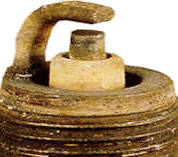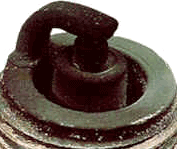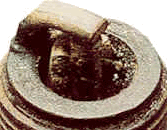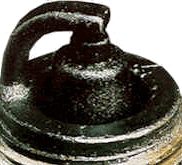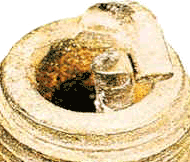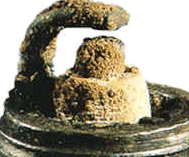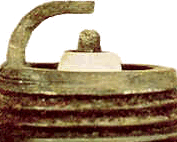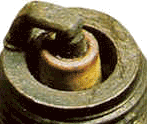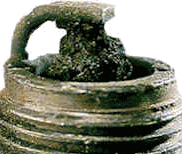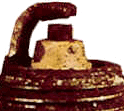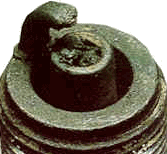|
Available Catalogue

|
I should add first up that any diagnostic plug readings shown are for leaded fuel. So basically my reading plug article have become redundant.
I could not find the chart I had in my workshop anywhere on the internet, it was quite good, but this one is OK. Remember though that the heat range of the plug must be correct before you can use this as a mixture guide.
|
|
|
|
|
Normal
Combustion deposits are slight and not heavy
enough to cause any detrimental effect on engine performance. Note the
brown to grayish tan color, and minimal amount of electrode erosion
which clearly indicates the plug is in the correct heat range and has
been operating in a "healthy" engine.
|
Carbon Fouled
Soft, black, sooty deposits easily
identify this plug condition. This is most often caused by an
over-rich, air/fuel mixture.
Check for a sticking choke, clogged air filter, or a
carburetor problem - float level high, defective needle or seat, etc.
This may also be attributed to weak ignition voltage,
an inoperative preheating system (carburetor intake air), or extremely
low cylinder compression.
|
Denotation
Failure
This form of abnormal combustion has
fractured the insulator core nose of the plug. The explosion that
occurs in this situation applies extreme pressures on internal engine
components. Prime causes include ignition time advanced too far, lean
air/fuel mixtures, and insufficient octane rating of the petrol.
|
|
|
|
|
|
Oil Fouled
Too much oil is entering the
combustion chamber. This is often caused by piston rings or cylinder
walls that are badly worn. Oil may also be pulled into the chamber
because of excessive clearance in the valve stem guides.A build-up of
crankcase pressure which can force oil and oil vapors past the rings
and valve guides into the combustion chamber can also cause this.
|
Mechanical
Damage
May be caused by a foreign object that
has accidentally entered the combustion chamber. When this condition
is discovered, check the other cylinders to prevent a re-occurence,
since it is possible for a small object to "travel" from one cylinder
to another where a large degree of valve overlap exists. This
condition may also be due to improper reach spark plugs that permit
the piston to touch or collide with the firing end.
|
Ash Fouled Plug
A build-up of combustion deposits stemming primarily from the burning of oil and/or fuel additives during normal combustion, normally non-conductive. When heavier deposits are allowed to accumulate over a longer mileage period, they can "mask" the spark, resulting in a plug misfire condition.
|
|
|
|
|
|
Overheated Spark Plug
A clean, white insulator firing tip and/or excessive electrode erosion indicates this spark plug condition. This is often caused by over advanced ignition, timing, poor engine cooling system efficiency, a very lean air/fuel mixture, or a
leaking intake manifold. When these conditions prevail, even a plug of the correct heat range will overheat
|
Insulator
Glazing
Glazing appears as a yellowish,
varnish-like color. This condition indicates that spark plug
temperatures have risen suddenly during a hard, fast acceleration
period. As a result, normal combustion deposits do not have an
opportunity to "fluff-off" as they normally do. Instead, they melt to
form a conductive coating and misfire will occur.
|
No Spark Plug
Gap
Rarely occurs in car engines, however,
this condition is caused by similar conditions that produce splash
fouling. Combustion deposits thrown loose may lodge between the
electrodes, causing a dead short and misfire. Fluffy materials that
accumulate on the side electrode may melt to bridge the gap when the
engine is suddenly put under a heavy load.
|
|
|
|
|
|
Splash Fouled Plug
Appears as "spotted" deposits on the firing tip of the insulator and often occurs after a long delayed tune-up. By-products of combustion may loosen suddenly when normal combustion temperatures are restored. During hard acceleration these materials shed from the piston crown or valve heads, and are thrown against the hot insulator surface.
|
|
Pre
Ignition
Usually one or a combination of
several engine operating conditions are the prime causes of
pre-ignition. It may originate from glowing combustion chamber
deposits, hot spots in the combustion chamber due to poor control of
engine heat, cross-firing (electrical induction between spark plug
wires), or the plug heat range is too high for the engine or its
operating conditions.
|
|
|


